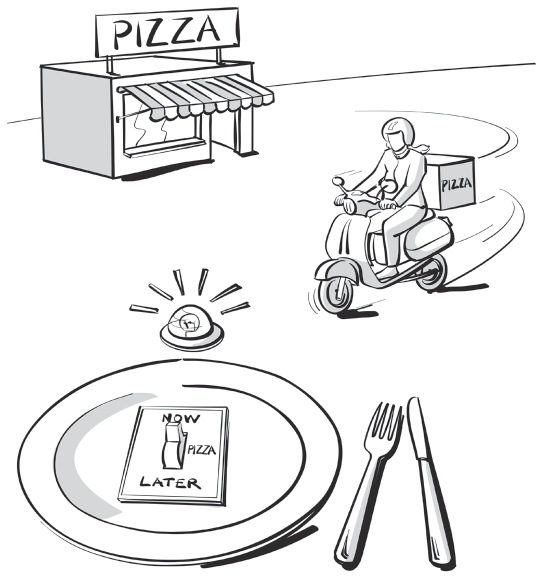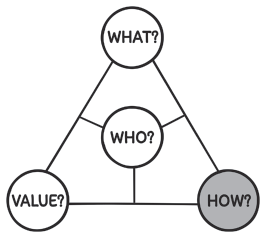Object as Point of Sale
Ordering where consumption takes place

The pattern
The Object as Point of Sale pattern represents another business model enabled by the increasing possibilities from IoT developments. Here, the point of sale of consumables moves to the point of consumption through the Internet-connected applications in easy-to-use ordering tools (HOW?). Through interconnectivity, separate devices are used for the final ordering process, while the point of purchase is close to the place of consumption. When the point of sale is shifted away from competing products, the customer becomes less sensitive to price. This generates a stronger Lock-In (#27) and enables higher customer retention.

Depending on the number and combination of sensors included in the object with which the customer can place orders, additional information can be used to optimise offerings regarding the purchasable product or complementary deals – for example, by approaching geo-specific marketing adapting to the radius where a device is located. Measuring the use of a device also brings knowledge of the need for complementary goods. In the case of coffee beans, for instance, this may be cleaning tablets for the coffee machine. The placement of suitable offers at the right time brings a large increase in sales potential that can also be used for partnering third-party companies.
Object as Point of Sale fits well with customer data-driven business models such as Hidden Revenue (#21) or Leverage Customer Data (#25). Here, referring to the Open Business model pattern (#32), combining data from different sources pushes the Object as Point of Sale potential to the next level by making the right calls to the respective customers in the appropriate situation. While Object Self-Service (#58) is an IoT-based business model pattern that places orders autonomously, Object as Point of Sale has to provide a trigger to the customer so that the final purchase is confirmed. This business model pattern centres around the idea of pushing the place of purchase to where the demand or need occurs.
The origins
First and foremost, the e-commerce giant Amazon made Object as Point of Sale approachable with its Amazon Dash concept. Here, Amazon released so-called ‘Dashes’ that were linked to a defined product (e.g. toilet paper) that is ordered in predefined amounts via the respective Amazon account when pressed. Very flexible in terms of physical placement because of the attached adhesive tape and to-be-ordered product, the button-like device is meant to be placed at the point of consumption. Newer versions of the device allow users to build a shopping list by scanning bar codes and saying product names out loud that are triggered by pushing the button. It connects directly with Amazon, through which the respective products are then ordered. Amazon Dash was Amazon’s first IoT device, but it is not available anymore. Amazon integrated the idea into its Alexa services, or through virtual buttons in digital devices of partner firms, as some courts found fault with the idea of physical Dash buttons. For instance, one legal flaw in the terms of use was that Amazon had the right to change the price or even to send the customer another comparable product.
Object as Point of Sale: Amazon Dash

The innovators
As a very recent business model, Ubitricity is one of the few companies applying the Object as Point of Sale pattern to the industry of charging electrical vehicles. Providing charging points across communities, users can access these to charge their electric car with a mobile charging cable. The intelligent cable has a mobile electric meter for exact billing when recharging electric vehicles, which incorporates the exact energy costs as they occur at the very spot where the charging takes place.
New concepts that are also approaching the Object as Point of Sale pattern are increasingly popular smart glasses. Available from companies such as Amazon, Apple, Google or Facebook, smart glasses can enable customers to purchase on the spot what they see.
When and how to apply Object as Point of Sale
Building on instant purchasing, the Object as Point of Sale is most suitable to consumables and goods that are often used in our everyday lives and are fluctuating in terms of consumption. In contrast to the Object Self-Service pattern (#58), which is especially suited for constant consumption levels and for products that are essential for certain processes, Object as Point of Sale also includes the choice to not order the respective product(s). Thus, additional mechanisms may be required to convince the customer in his/her decision to buy – be it via digital advertisement, brand value or other creative means of persuasion. It is important to consider the legal side too, as in the case of Amazon Dash.
Some questions to ask
- Which convincing mechanisms are additionally in place to push the customer towards a purchase decision?
- Is our product consumed constantly by the customer?
- Do we have the position to take the intermediary role and bring the customer to the products he/she wants to order on the spot?
- Can we manage the complexity of the additional aftersales business? Who are potential partners for that business?
- Is our product convincing enough to be purchased by customers on the spot?
